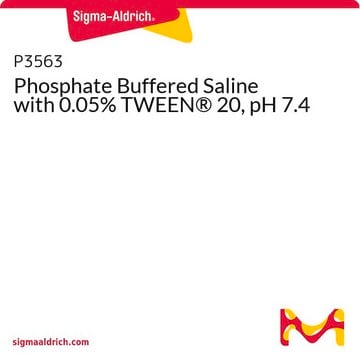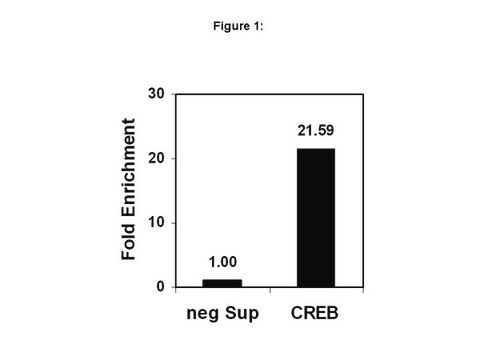MAB979
Anti-Enterovirus 71 Antibody, cross-reacts with Coxsackie A16, clone 422-8D-4C-4D
ascites fluid, clone 422-8D-4C-4D, Chemicon®
Autenticatiper visualizzare i prezzi riservati alla tua organizzazione & contrattuali
About This Item
Codice UNSPSC:
12352203
eCl@ss:
32160702
NACRES:
NA.41
Prodotti consigliati
Origine biologica
mouse
Livello qualitativo
Forma dell’anticorpo
ascites fluid
Clone
422-8D-4C-4D, monoclonal
Reattività contro le specie
human
Produttore/marchio commerciale
Chemicon®
tecniche
immunofluorescence: suitable
Isotipo
IgG1
Condizioni di spedizione
wet ice
Specificità
Reacts with Enterovirus 71. Neutralizes enterovirus 71 BrCr strain at a titer of less than 1:14.
Immunogeno
Epitope: cross-reacts with Coxsackie A16
Applicazioni
Indirect immunofluorescence at 1:1,000.
(Also cross-reacts with Coxsackie A16).
Optimal working dilutions must be determined by end user.
(Also cross-reacts with Coxsackie A16).
Optimal working dilutions must be determined by end user.
Research Category
Infectious Diseases
Infectious Diseases
Research Sub Category
Infectious Diseases - Viral
Infectious Diseases - Viral
This Anti-Enterovirus 71 Antibody, cross-reacts with Coxsackie A16, clone 422-8D-4C-4D is validated for use in IF for the detection of Enterovirus 71.
Stato fisico
Ascites fluid containing no preservatives.
Unpurified
Stoccaggio e stabilità
Maintain for 1 year at -20°C from date of shipment. Aliquot to avoid repeated freezing and thawing. For maximum recovery of product, centrifuge the original vial after thawing and prior to removing the cap.
Risultati analitici
Control
Enterovirus Control Slides, Catalogue Number 5066
Enterovirus Control Slides, Catalogue Number 5066
Altre note
Concentration: Please refer to the Certificate of Analysis for the lot-specific concentration.
Note legali
CHEMICON is a registered trademark of Merck KGaA, Darmstadt, Germany
Esclusione di responsabilità
Unless otherwise stated in our catalog or other company documentation accompanying the product(s), our products are intended for research use only and are not to be used for any other purpose, which includes but is not limited to, unauthorized commercial uses, in vitro diagnostic uses, ex vivo or in vivo therapeutic uses or any type of consumption or application to humans or animals.
Codice della classe di stoccaggio
10 - Combustible liquids
Classe di pericolosità dell'acqua (WGK)
WGK 1
Punto d’infiammabilità (°F)
Not applicable
Punto d’infiammabilità (°C)
Not applicable
Certificati d'analisi (COA)
Cerca il Certificati d'analisi (COA) digitando il numero di lotto/batch corrispondente. I numeri di lotto o di batch sono stampati sull'etichetta dei prodotti dopo la parola ‘Lotto’ o ‘Batch’.
Possiedi già questo prodotto?
I documenti relativi ai prodotti acquistati recentemente sono disponibili nell’Archivio dei documenti.
Elizabeth A Caine et al.
Journal of virology, 90(19), 8592-8604 (2016-07-22)
Hand, foot, and mouth disease (HFMD) has spread throughout the Asia-Pacific region, affecting millions of young children, who develop symptoms ranging from painful blisters around their mouths and hands to neurological complications. Many members of the genus Enterovirus (family Picornaviridae)
Ming-Te Yeh et al.
PloS one, 6(11), e27082-e27082 (2011-11-10)
Enterovirus 71 (EV71) has emerged as a neuroinvasive virus responsible for several large outbreaks in the Asia-Pacific region while virulence determinant remains unexplored. In this report, we investigated increased virulence of unadapted EV71 clinical isolate 237 as compared with isolate
Combining multiplex reverse transcription-PCR and a diagnostic microarray to detect and differentiate enterovirus 71 and coxsackievirus A16.
Chen, Tsan-Chi, et al.
Journal of Clinical Microbiology, 44, 2212-2219 (2006)
Kan Xing Wu et al.
Nature communications, 7, 13150-13150 (2016-10-18)
Enterovirus 71 (EV71) is a neurotropic enterovirus without antivirals or vaccine, and its host-pathogen interactions remain poorly understood. Here we use a human genome-wide RNAi screen to identify 256 host factors involved in EV71 replication in human rhabdomyosarcoma cells. Enrichment
Rei-Lin Kuo et al.
PloS one, 8(5), e63431-e63431 (2013-05-08)
Induction of type-I interferons (IFNs), IFN-α/β, is crucial to innate immunity against RNA virus infection. Cytoplasmic retinoic acid-inducible gene I (RIG-I)-like receptors, including RIG-I and melanoma differentiation-associated gene 5 (MDA5), are critical pathogen sensors for activation of type-I IFN expression
Il team dei nostri ricercatori vanta grande esperienza in tutte le aree della ricerca quali Life Science, scienza dei materiali, sintesi chimica, cromatografia, discipline analitiche, ecc..
Contatta l'Assistenza Tecnica.






